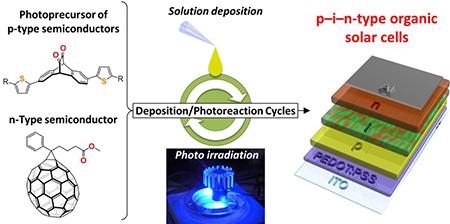Materials Science 2014/11/25
Professor Hiroko Yamada, Assistant Professor Mitsuharu Suzuki
Laboratory for photofunctional organic chemistry
The group of Prof. Hiroko Yamada in Graduate School of Materials Science has, in collaboration with Prof. Ken-ichi Nakayama's group in Yamagata University, developed a unique approach to make organic solar cells that contain three layers (p-, i-, and n-layers) of semiconducting materials. This approach employs solution-processable precursor compounds which can be converted to insoluble organic semiconductors through a photochemical reaction. By repeating the cycle of solution deposition and photoreaction, multi-layer structures can be constructed without dissolving underlying layers (Figure). This approach is expected to be more cost-effective and easily scalable in comparison with expensive vacuum processes.
Most of currently available high-performance organic solar cells are the type of bulk-heterojunction (BHJ), which have a single layer of mixed semiconductors comprising an electron-rich p-type material and an electron-deficient n-type material. The three-layer structure prepared by Yamada's team, on the other hand, has a blend film (i-layer) sandwiched between layers of neat p-type and n-type material (p- and n-layer, respectively). The research group showed with one of their proof-of-concept systems that photovoltaic efficiency was more than doubled in a three-layer (p-i-n-type) device compared with the corresponding BHJ-type device.
The precursor compounds used in this study can be converted to the target semiconducting materials under extremely mild conditions--visible-light irradiation without the need for any thermal treatment. Thus, organic semiconducting films can be directly formed on thermally labile support substrates including flexible plastic films. In addition, film morphology can be controlled by photoirradiation conditions such as light intensity and temperature. It is also possible to employ different compounds in different layers, allowing the use of 'tailor-made' semiconductors in each layer. This flexibility in choosing support substrates, photoreaction conditions, and semiconducting materials will help boost the further development of organic solar cells.
The paper describing these results has been published in Scientific Reports (Nature Publishing Group) on November 21, 2014 (doi: 10.1038/srep07151).

Figure




